R is a programming language for statistical computing, data analysis, and data visualization. Though its popularity is far behind Python, the language is still compelling and fast, hence optimal for performing complicated tasks.
Undoubtedly, R is being used by a growing number of data analysts and business analysts globally. Hence, if you want to pursue a lucrative career in data science and machine learning, learning R would be essential.
Compared to other programming languages, R has a straightforward syntax. Thus, it is not too challenging for self-studying. You can master the language by taking a few high-quality online courses.
However, this does not mean that you can take any random courses that are available online. Most online courses claimed to teach the R programming language are a cash grab. You are unlikely to learn much from them.
I will help you solve that problem. This article will only feature the best R programming courses that I found helpful in your practical skills. You can then select the course that suits your preferences and start learning right away.
Affiliate Disclosure: This article from Victory Tale contains affiliate links. We will receive a small commission from our partners if you purchase courses through those links.
Nevertheless, we always value integrity and prioritize our audience’s interests. You can rest assured that we will present each course truthfully.
Things You Should Know
Prerequisites
Most R programming courses have no prerequisites. Hence, anyone can enroll and start learning at will. However, prior experience in other programming languages (Python, C++, JavaScript, etc.) would be beneficial.
Criteria
Below are the criteria for the best R courses:
1. Programming for Data Science with R
This Nanodegree program from Udacity is unarguably one of the best training courses if you want to learn R for data science.
Besides R fundamentals, you will also learn about SQL (for database management) and Git (for version control). Upon completion, you will possess essential skillsets that will allow you to pursue a career in data science confidently.
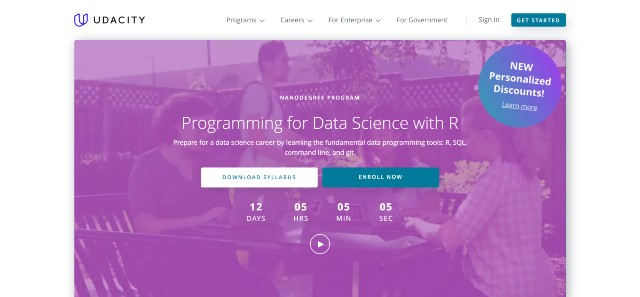
Course Content
This program consists of three sections as follows:
1. Introduction to SQL – The first section will introduce you to SQL. You will learn the fundamentals of this structured query language, such as SQL commands, JOINs, Aggregations, and Subqueries.
Subsequently, you will learn to use SQL to solve real-life business problems.
2. Introduction to R Programming – The second section will guide you through foundational concepts of the R programming language, including variables, control flows, and functions.
In the second part of the course, you will use ggplot2 to visualize the data.
3. Introduction to Version Control – The final section will explain how to perform version control, share your project, and collaborate with other professionals through Git. All of these skills are essential for data scientists and programmers alike.
You will work on numerous assignments in all three sections, including quizzes and a real-world project. For example, you will use R to collect, analyze, and visualize US bikeshare data from three cities.
Completing these assignments will provide you with opportunities to practice what you have learned and acquire valuable hands-on experience.
According to Udacity, you should spend 10 hours each week on the program, and you will complete it in three months.
The suggested learning pace may be too intense for some. However, the program is self-paced. You can then set up your study schedule at will. Just keep in mind that the more time you need, the higher the tuition fees (see below).
Student Support
Student support is what differentiates Udacity from its competitors. Once enrolled, you can access three types of student support as follows:
1. Technical Mentor Support – If you encounter any problems with the course or simply get stuck on assignments, you can always use the chat interface on Student Hub to ask technical questions to the team of mentors (they are available 24/7).
In most cases, you will receive a reply in less than an hour, which is far faster than other learning platforms. With this timely support, you can be confident that your learning will not be interrupted by technical issues.
Project Reviews – Like web development bootcamps, Udacity offers project review services for all students. In other words, you can send unlimited requests to experts to review your work. Within a few hours, you will receive detailed feedback and guidance on best practices that you can grasp to improve your code.
The best part is that your project does not have to meet particular criteria or reach a certain milestone to be eligible for expert reviews. You can send requests anytime you want, creating a healthy feedback loop that could be highly instrumental in developing your R programming skills.
Career Services – Many applicants do not succeed in job applications because their public profiles are unprofessional. Udacity will thus assist you in these tedious tasks.
The team will review your resume, LinkedIn profile, and Github portfolio to ensure that they properly showcase your achievements (i.e., statistical data analysis projects you have completed) and relevant skills. Hence, you are more likely to receive interview invitations from your dream companies.
Pricing
Udacity utilizes a subscription-based pricing model. The tuition fees for this program are $399 monthly, but you can buy a 3-month bundle that will lower the costs by 15% to $339 per month.
However, that’s not all. You can create an account (like I did below) to access personalized or account-based discounts.
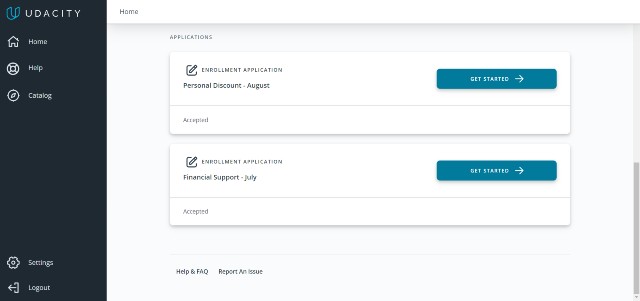
These offers can be as high as 75% off. Hence, you can enroll in this top-notch program by investing only $100 or lower per month.
[sc name=”udacity” ][/sc]Pros & Cons
Pros
- Learn from a team of veteran data scientists and machine learning engineers with years of experience. Some of whom are ex-programming Bootcamp instructors.
- Beginner-friendly program
- Straightforward curriculum
- In-depth, informative lessons
- Acquire other essential skillsets (apart from R programming) that will help you confidently apply for data science positions.
- Multiple assignments and real-world projects are available for students to obtain hands-on experience.
- Timely, Bootcamp-like student support
Cons
- Costlier than other alternatives
- Udacity projects are typically challenging for absolute beginners.
2. Datacamp’s R courses
Datacamp is a data science learning platform with a unique approach. Instead of teaching students through video lessons, Datacamp utilizes gamified interactive learning to provide students with a more entertaining experience.
I find this approach exceptional in keeping me learning. Hence, if you have taken some R programming courses but get bored extremely fast, you may want to give Datacamp a try.
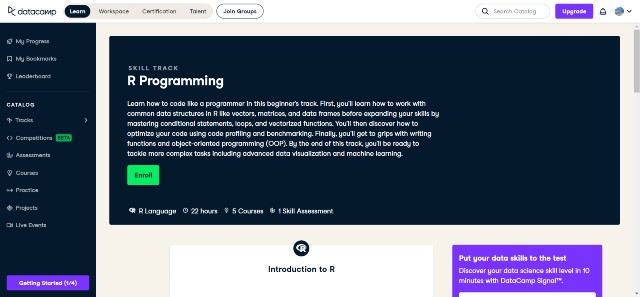
Course Content
Datacamp offers more than 190 R courses covering numerous data science topics, including but not limited to
- Introduction to R
- Introduction to Statistics in R
- Data Visualization in R
- Time Series Analysis in R
- Web Scraping in R
- Introduction to R for Finance
All courses will be grouped into skill tracks such as R Programming, Data Manipulation, Marketing Analytics, and many more. These skill tracks will help students take the courses in the proper order.
You will read the instructions and perform the tasks through the web-based IDE. If you get stuck, you can take a hint or request the platform to reveal the solutions. In most cases, you will complete each course in 4-6 hours or even faster.
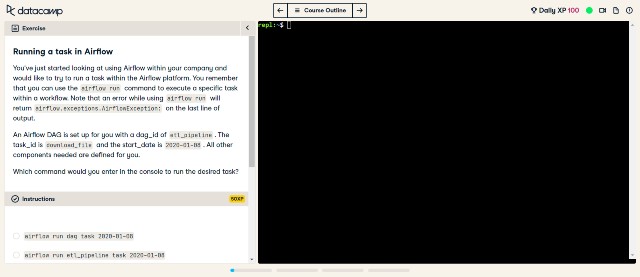
Once you have completed several courses, you can also work on real-world projects. These projects will help you put all you have learned together and understand real-life tasks performed by data science professionals.
Based on my observation, the course content and projects are beginner-friendly. They will help you gradually develop your skills and gain confidence. However, the course content is not very in-depth, while the projects are not very challenging, especially if you compare them to Udacity’s.
Therefore, Datacamp will propel absolute beginners to the intermediate level and stop right there. If you want to truly master a particular topic, you will need a course from another provider.
Despite the drawbacks, Datacamp is undoubtedly worth subscribing to. Absolute beginners can benefit handsomely from Datacamp’s entertaining approach and diverse curriculum.
If you manage to complete all Datacamp courses, you will master all the essentials and be confident to kickstart your journey in data science.
Pricing
Like Udacity, Datacamp uses a subscription-based pricing model. The following are the plans that students have to choose one to subscribe to (billed annually).
- Premium – starting at $12.42 per month
- Team – $25 per month
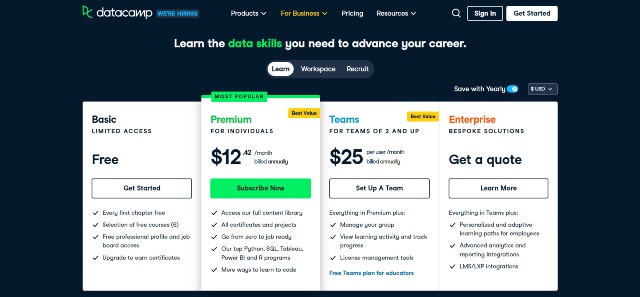
The Standard plan will provide unlimited access to all 300+ courses on the platform (R, Python, Scala, etc.) along with 80+ projects, along with Tableau, Power BI, and Oracle training.
The Premium plan is more than sufficient for most students who want to learn R programming.
However, please be informed that Datacamp subscriptions are frequently on sale (at least once per quarter). The Premium plan can cost less than $5 per month during that period.
If you are still unsure if Datacamp is for you, I suggest you create a free account to try the first lesson of each course for free.
Pros & Cons
Pros
- Best R programming course for those who detest video lessons
- Beginner-friendly, diverse curriculum with more than 190+ courses on R programming, ranging from R basics to various applications
- Entertaining lessons
- Learn anytime and anywhere through Datacamp’s high-quality apps (iOS/Android)
- All-in-one subscription – You can take all the data science courses on the platform, including Python, Scala, Big Data, and many more.
- Take the first lesson for each course for free
Cons
- None of the courses drill deep into advanced concepts. You will need another course if you want to master R programming.
- The platform provides too much code for each assignment and project in some advanced courses. This approach makes the assignments far less challenging and deprives students of opportunities to think like a programmer and code everything from scratch.
3. Dataquest’s R Courses
Dataquest is Datacamp’s archrival. The platform utilizes the same interactive learning approach that allows students to have an immersive experience. Hence, if you are an absolute beginner, Dataquest’s courses would prove highly beneficial.
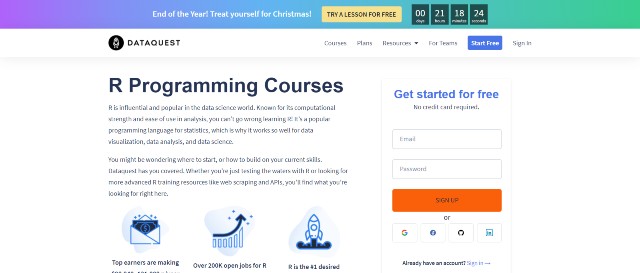
Course Content
As of December 2021, Dataquest offers dozens of R programming courses. These are grouped into skill paths that form an orderly curriculum so that students can progress smoothly.
Currently, there are five R programming skill paths that you can choose from as follows:
- Data Analyst in R – You will learn the foundational concepts of R programming and use them to perform data analysis.
- Data Visualization with R – This skill path will guide you in visualizing data with R.
- Probability and Statistics with R – This skill path will introduce you to the fundamentals of probability and statistics (Bayesian statistical inference, hypotheses, distributions, etc.) Subsequently, you will use R to perform statistical analysis, handle probability density functions, and prove hypotheses.
- APIs and Web Scraping with R – The final skill path will explain how to gather data from the web and APIs for effective data analysis.
Overall, Dataquest’s curriculum is significantly less diverse than Datacamp’s. However, Dataquest is currently active in expanding the curriculum. Thus, you should expect more courses to be released soon.
The learning experience is quite similar to Datacamp. First, you will read the text instructions and complete the coding assignments on the web-based IDE.
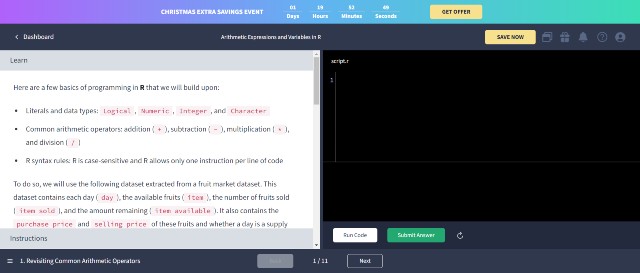
I also found that Dataquest’s courses are more or less as in-depth as Datacamp’s, which means that you will need to find another course elsewhere if you want to build advanced R programming skills.
However, Dataquest spoon-feeds learners much less than Datacamp. You will have more opportunities to properly code everything from scratch.
Pricing
Dataquest’s plans are straightforward. The premium plan starts at $33.25 per month (billed annually) or $49 if you select monthly billing. Once you subscribe, you can access all data science courses on the platform, including R, Python, SQL, and many more.
Based on my observation, Dataquest offers discounts almost every month. These discounts can be as high as 50%, lowering subscription fees to $16.5 monthly.
You can also create an account to try some lessons for free.
Pros & Cons
Pros
- Well-structured skill paths that allow smooth navigation of courses
- Beginner-friendly lessons
- Employ interactive learning approaches that provide an excellent learning experience
- Offer more opportunities for students to code everything from scratch
- All-in-one pricing: Once subscribed, you can take all other data science courses on the platform.
- Numerous free content that you can access for free
Cons
- The curriculum is essentially “under construction,” with more content to be added soon.
- Courses do not drill deep into advanced-level content.
- Unlike Datacamp and most other learning platforms featured in this article, Dataquest does not offer a mobile app.
4. R Programming by Kirill Eremenko
This series of two Udemy courses by Kirill Eremenko will guide you through the essence of R programming and grasp how to use the language in statistics and data science.
I have taken several courses with him and appreciate his concise explanation of concepts. Hence, I do not hesitate to recommend him to you.
Note: You will need to purchase each course in this series separately since Udemy does not use bundle pricing.
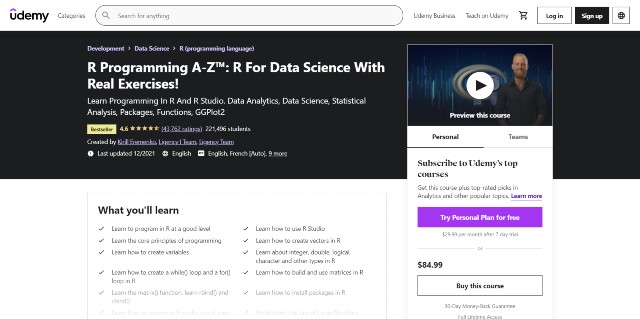
4.1) R Programming A-Z™: R For Data Science With Real Exercises!
The first course of the series will delve into the basics. Below is a summary of what you will learn from the course.
- Core Programming Principles (Variables, Operators, Control Flows)
- R Programming Fundamentals (Vectors, Functions, Packages)
- Deep dive into Matrices (Operations, Visualization, etc.)
- Data Frames
- Advanced visualization with GGPlot2
- Detailed Homework Solutions
The video content is 10.5 hours long. Besides the video lessons, Kirill has provided multiple assignments based on real-world scenarios to help you grasp the practicals.
For example, you will analyze financial statements and movie gross data using R programming. Once you have completed the assignments, you can watch the video solutions that will explain all the steps in detail. Hence, you will have all the learning resources you need to master R.
Reviews: 4.6/5.0, Students: 221000+
4.2) R Programming: Advanced Analytics In R For Data Science
The second course mainly covers data analytics in R. Below are the key topics that you will learn from this course.
- Data Preparation (Learn to prepare data for analysis in R)
- Median Imputation Method (to replace missing data)
- Deep dive into Lists in R (Date-Times, Import data into R, Create a Timeseries Plot, etc.)
- “Apply” family of functions + Nesting Functions
This course is substantially shorter than the first (only 6 hours long) since it covers far fewer topics. However, the instructor will still drill deep into each concept and provide you with real-world case studies that help you understand the concepts.
Overall, both courses are beginner-friendly. If you are looking for an affordable R programming course, I think this series is worth trying.
Reviews: 4.6/5.0, Students: 53000+
Pros & Cons
Pros
- Learn from a veteran data scientist
- Well-structured curriculum
- Concise explanations of concepts
- Quizzes and assignments of the first course are based on real-world scenarios: Hence, students can grasp how to use the concepts in real life.
- Detailed homework solutions
- Lifetime Access + 30-day money-back guarantee
- Inexpensive ($20 or lower when on sale)
Cons
- Inactive Q&A Forum: Many students fail to access the instructor’s assistance.
- Some students reported that despite creating the “advanced” course, the instructor still has not drilled deep into the advanced-level content.
5. Data Science: Foundations using R Specialization
If you are looking for more formal training, this Coursera specialization from John Hopkins University may suit you the most. You learn from three biostatistics professors who will guide you through data science tools and techniques with R.
The course page indicates that this program has no prerequisites. However, student reviews suggest otherwise. It will be optimal if you have a programming background before enrolling in this program.
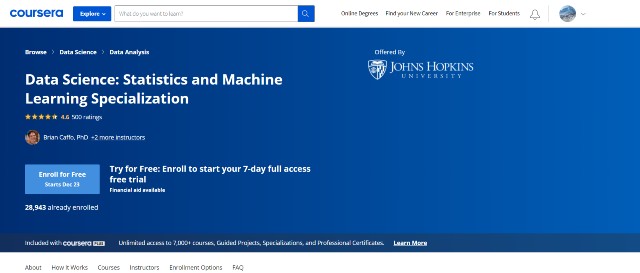
Course Content
This specialization comprises five minor courses as follows:
1. The Data Scientist’s Toolbox – This brief course will introduce you to how data scientists turn data into insights and guide how to use crucial tools, including Git and RStudio.
2. R Programming – In essence, the second course will teach you the essence of R programming. You will start by setting up a statistical programming environment. Later, you will learn about programming concepts, including functions, packages, and coding best practices.
3. Getting and Cleaning Data – The third course will explain how to gather data effectively from various sources, including the web, APIs, and many more.
Subsequently, you will learn how to clean and polish your data and perceive how “tidy” data can benefit data analytics tasks.
4. Exploratory Data Analysis – The fourth course will cover exploratory techniques to summarize data that will be beneficial for developing complex statistical models and evaluating hypotheses. You will also learn about the plotting systems in R and the principle of data visualizations.
5. Reproducible Research – The final course will discuss the tools and techniques behind reproducible data analysis reports. You will grasp why reproducibility is beneficial for the community.
Overall, you will learn R programming and perceive how to perform data analysis professionally. The curriculum is comprehensive. You may not need another R programming course at all.
John Hopkins recommends spending 8 hours per week on the courses, and you will complete the program in five months.
However, since the program is self-paced, you can adjust your learning schedule at will if you believe the suggested pace is too intense.
You can audit the program for free. Alternatively, you can opt for a full course, which costs $49 per month and provides access to graded assignments and a digital certificate.
Important Note: I admit that I did hesitate to recommend this program at first because it has many issues. Based on my observations, students seem to encounter numerous problems with the graded assignments. Some of the course materials are now inaccessible.
However, I appreciate the comprehensiveness of the curriculum and believe the course can be of some value for students who want to learn R programming. I thus suggest you stick to the free auditing option.
Pros & Cons
Pros
- Learn R programming from professors at a world-renowned university
- Well-structured, comprehensive curriculum
- Free auditing
Cons
- Not beginner-friendly
- The assignments are extremely challenging for absolute beginners. In some cases, you might need to read the official documentation (like professional programmers do in real life) to complete them. I find this approach useful, but it does frustrate numerous students.
- Some course materials are outdated and thus inaccessible.
6. Data Visualization & Dashboarding with R Specialization
This Coursera specialization will explain how to visualize data and create a robust dashboard with R. Like Course 4, you will learn from a senior lecturer at John Hopkins University.
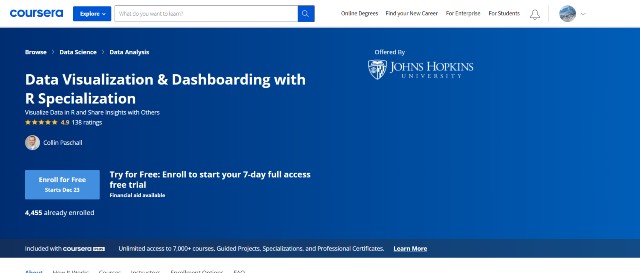
Course Content
This specialization comprises four minor courses and one capstone project as follows:
1. Getting Started with Data Visualization in R – The first course will equip you with the essential skills for data visualization in R. You will learn R programming fundamentals such as basic R syntaxes, functions, and Dataframes.
Subsequently, you will learn how to import data into R, use multiple tools to manipulate data, and finish the course by creating basic reports.
2. Data Visualization in R with ggplot2 – The second course is all about ggplot2. You will use this package to visualize data and polish it using various tools (including a third-party vector graphics editing software.)
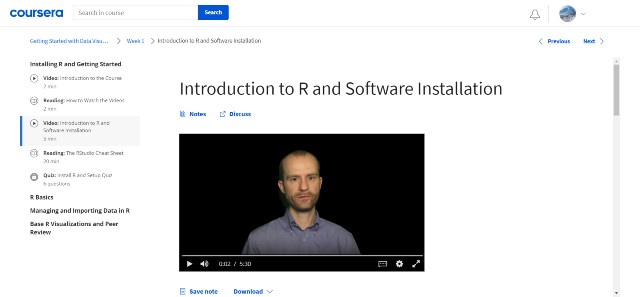
3. Advanced Data Visualization with R – The third course will continue where the second left off. You will learn more about data visualization options with R by exploring other packages. Later, you will make spatial maps in R and create animating figures.
4. Publishing Data Visualization in R with Shiny and FlexDashboard – The final course will discuss steps to use Shiny to visualize data and create interactive dashboards to convey insights to the audience.
5. Capstone – This large-scale project will provide you with opportunities to apply what you have learned. You will create a wide variety of visualizations in R to tell a compelling story based on real-world data.
Unlike other courses on the list, this one focuses only on data visualizations with R. Besides the video lessons and readings, the program offers numerous assignments and a large-scale project that help you practice your skills.
Hence, if you believe you are still not proficient in this area, you may want to give this specialization a try.
Regarding the pace, you should spend 5 hours per week on the course, and you will complete it in four months. However, I think you can complete it much earlier if you are a fast reader. This is because the video lessons are pretty short, and you spend most of your study time on the readings.
Auditing all the minor courses is free. Alternatively, you can subscribe to a full program at $49 per month.
Pros & Cons
Pros
- Easy-to-follow curriculum
- Clear, detailed explanations of concepts and processes
- Well-made quizzes and assignments that help you understand R syntaxes and steps to create compelling data visualizations
- Prepare students for future self-learning (i.e., explain how to read official documentation)
- Free auditing
Cons
- The specialization contains only a few short video lessons, which may not be optimal if you do not want to learn through reading.
- The transcripts are not organized, so they are tough to read.
Coursera Plus
Since this article features multiple Coursera specializations, you may be interested in more than a single program. If that is the case, I recommend subscribing to Coursera Plus.
Coursera Plus will grant full access (not just auditing) to more than 3000 courses and specializations on the Coursera platform. You can then enroll in each instantly without the need to pay subscription fees to individual programs.
In addition, the fees for Coursera Plus start at $399 per year (or $33.25 per month on average), which is cheaper than that of individual subscriptions ($39-$79). Hence, Coursera Plus apparently offers more value for money.
If you are a studious student, subscribing to Coursera Plus is a 100% wise decision.
[sc name=”coursera” ][/sc]Other Alternatives
Below are some of the alternatives that you can also consider. However, all of them have issues. That’s why I chose not to recommend them on the above list.
Codecademy – Like Datacamp, Codecademy is a platform that utilizes interactive learning. However, its courses are even less in-depth than Datacamp and Dataquest. The best thing is that you can take some beginner-level courses for free.
365 Data Science – This data science learning platform offers excellent training on various data science topics, including R programming, at an all-in-one pricing.
However, as of December 2021, its R course is still not as detailed as those on the above list. If the platform releases more content on R programming, I might feature it more extensively in the future.
Statistics with R Specialization – At first, this specialization appears to be one of the best options to learn statistics with R. The first three minor courses are well-made. Unfortunately, the final course is not. All the content in that course is poorly explained, frustrating many students.
Applied Data Science with R Specialization – This Coursera specialization from IBM trains students to use R to transform data into insights through a series of five courses.
However, students reported that the instructors did not explain fundamental concepts in detail, making the course content difficult to follow. Still, students already familiar with data analytics can try the courses.
Data Analysis with R Programming – This Coursera specialization from Google explains how to perform data analysis tasks with R in detail. However, based on the reviews, though the course provides some helpful information, the instructions are not well-organized and substandard in quality.
R Programming for Statistics and Data Science 2022 – This top-rated Udemy course from 365 Careers guides beginners on effectively using R programming for statistics and data science. Unfortunately, the overall content is too concise (6.5 hours), which is inadequate for my recommendation.
Data Science and Machine Learning Bootcamp with R – This is another top-ranked Udemy course that explains R programming in detail. However, the instructor has not updated the content for more than a year.
LinkedIn Learning – LinkedIn Learning offers plenty of R programming courses on its platform. However, most of the courses have not received updates for several years. Thus, I don’t think the learning experience would be optimal.
Related Courses
Below are direct links to articles that feature the best courses on different topics that may be beneficial for those interested in data science.
- Machine Learning – Machine Learning is an excellent subject that you may want to learn after completing R courses. You will learn how to train models to perform various tasks.
- Deep Learning – Another lucrative skillset along with machine learning that an R programmer should possess
- Python – A more popular alternative to R, best choice if you want to learn data science
- Data Engineering – Crucial topics to learn if you want to become a data engineer
- Computer Vision – Learn how to train computers and machines to perceive and identify objects in the surrounding environment. Computer Vision is one of the ultimate skills to master if you want to pursue a career in data science and machine learning.
- Data Analytics